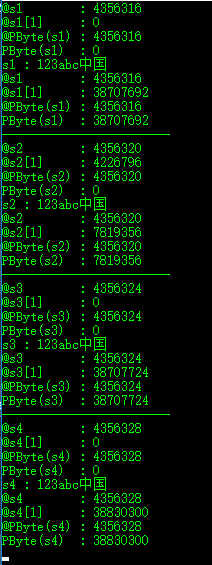闲来无事,又开始扒拉起Delphi的源码,这次发现一个比较有意思的函数StringCodePage,作用是返回传入字符串的CodePage。至于什么CodePage,暂且认为是字符编码吧。
先测试一把:
var
s1: AnsiString;
s2: WideString;
s3: UTF8String;
cp1, cp2, cp3: Word;
begin
s1 := '123abc中国';
s2 := '123abc中国';
s3 := '123abc中国';
cp1 := StringCodePage(s1); //936 - GBK(简体中文)
cp2 := StringCodePage(s2); //1200 - UCS-2LE Unicode 小端序
cp3 := StringCodePage(s3); //65001 - UTF-8 Unicode
end;
来看下是怎么实现的:
function StringCodePage(const S: UnicodeString): Word; overload;
begin
if S <> '' then
Result := PWord(PByte(S) - 12)^ // StrRec.codePage
else
Result := Word(DefaultUnicodeCodePage);
end;
原来字符串首地址逆向偏移12个字节所存放的Word型数据就是该字符串的CodePage信息。注释里出现了一个StrRec,看一下是何方神圣:
StrRec = packed record
codePage: Word; //代码页
elemSize: Word; //元素大小
refCnt: Integer; //引用计数
length: Integer; //字符串长度
end;
两个Word两个Integer刚好12B,那就看下所有字节吧:
function BytesToHex(p: PByte; len: Integer): string;
var
i: Integer;
begin
Result := '';
for i := 0 to len - 1 do
Result := Result + ' ' + IntToHex((p + i)^, 2);
Result := Trim(Result);
end;
var
s1: AnsiString;
s2: WideString;
s3: UTF8String;
s4: UnicodeString;
hex1, hex2, hex3, hex4: string;
begin
s1 := '123abc中国';
s2 := '123abc中国';
s3 := '123abc中国';
s4 := '123abc中国';
hex1 := BytesToHex(PByte(s1) - 12, Length(s1) + 12);
hex2 := BytesToHex(PByte(s2) - 12, Length(s2) * 2 + 12);
hex3 := BytesToHex(PByte(s3) - 12, Length(s3) + 12);
hex4 := BytesToHex(PByte(s4) - 12, Length(s4) * 2 + 12);
//hex1: A8 03 01 00 01 00 00 00 0A 00 00 00 31 32 33 61 62 63 D6 D0 B9 FA
//hex2: 86 06 D4 26 5E AC 00 18 10 00 00 00 31 00 32 00 33 00 61 00 62 00 63 00 2D 4E FD 56
//hex3: E9 FD 01 00 01 00 00 00 0C 00 00 00 31 32 33 61 62 63 E4 B8 AD E5 9B BD
//hex4: B0 04 02 00 01 00 00 00 08 00 00 00 31 00 32 00 33 00 61 00 62 00 63 00 2D 4E FD 56
end;
查一下各个字符的编码备用:123abc的ASCII码就不必说了;中的GBK编码D6D0,Unicode编码4E2D,UTF-8编码E4B8AD;国的GBK编码B9FA,Unicode编码56FD,UTF-8编码E59BBD。
先看s1,codePage:A8 03,elemSize:01 00,refCnt:01 00 00 00,length:0A 00 00 00,字符串内容:31 32 33 61 62 63 D6 D0 B9 FA。
字符串内容比较好理解,与具体编码也都一一对上了,但是其它的又是怎么回事呢?用PWord和PInteger去取的话又是没问题的啊!其实是编译器大端、小端的问题,至于大小端问题这里不讨论,知道这里用的是小端就可以了。
按小端来解析s1,codePage:03 A8=936,elemSize:00 01=1,refCnt:00 00 00 01=1,length:00 00 00 0A=10。
s2就比较头大了,前8个字节总是变来变去,length:00 00 00 10=16,字符串内容按小端来解析也是没问题的。
其中有这样一段代码:
function _WStrLen(const S: _WideStr): Integer; inline;
{$IFDEF CPU64BITS}
begin
Result := 0;
if Pointer(S) <> nil then
{$IFDEF MSWINDOWS}
Result := PInteger(PByte(S) - 4)^ shr 1;
{$ELSE}
Result := PInteger(PByte(S) - 4)^;
{$ENDIF}
end;
{$ELSE !CPU64BITS}
begin
Result := IntPtr(S);
if Result <> 0 then
{$IFDEF MSWINDOWS}
Result := PInteger(PByte(Result - 4))^ shr 1;
{$ELSE}
Result := PInteger(PByte(Result - 4))^;
{$ENDIF}
end;
{$ENDIF !CPU64BITS}
意思是说求WideString的长度时,windows平台下还需要右移一位。
s3,codePage:FD E9=65001,elemSize:00 01=1,refCnt:00 00 00 01=1,length:00 00 00 0C=12,字符串内容与UTF-8编码一致。
s4按小端来解析,codePage:04 B0=1200,elemSize:00 02=2,refCnt:00 00 00 01=1,length:00 00 00 08=8,字符串内容UCS-2LE编码一致。
这里发现一个重大问题:WideString和UnicodeString虽然在内容上一样,但具体实现却是不同的。
var
s1: AnsiString;
s2: WideString;
s3: UTF8String;
s4: UnicodeString;
begin
Writeln('@s1 : ', Cardinal(@s1));
Writeln('@s1[1] : ', Cardinal(@s1[1]));
Writeln('@PByte(s1) : ', Cardinal(@PByte(s1)));
Writeln('PByte(s1) : ', Cardinal(PByte(s1)));
s1 := '123abc中国';
Writeln('s1 : ', s1);
Writeln('@s1 : ', Cardinal(@s1));
Writeln('@s1[1] : ', Cardinal(@s1[1]));
Writeln('@PByte(s1) : ', Cardinal(@PByte(s1)));
Writeln('PByte(s1) : ', Cardinal(PByte(s1)));
Writeln('------------------------');
Writeln('@s2 : ', Cardinal(@s2));
Writeln('@s2[1] : ', Cardinal(@s2[1]));
Writeln('@PByte(s2) : ', Cardinal(@PByte(s2)));
Writeln('PByte(s2) : ', Cardinal(PByte(s2)));
s2 := '123abc中国';
Writeln('s2 : ', s2);
Writeln('@s2 : ', Cardinal(@s2));
Writeln('@s2[1] : ', Cardinal(@s2[1]));
Writeln('@PByte(s2) : ', Cardinal(@PByte(s2)));
Writeln('PByte(s2) : ', Cardinal(PByte(s2)));
Writeln('------------------------');
Writeln('@s3 : ', Cardinal(@s3));
Writeln('@s3[1] : ', Cardinal(@s3[1]));
Writeln('@PByte(s3) : ', Cardinal(@PByte(s3)));
Writeln('PByte(s3) : ', Cardinal(PByte(s3)));
s3 := '123abc中国';
Writeln('s3 : ', s3);
Writeln('@s3 : ', Cardinal(@s3));
Writeln('@s3[1] : ', Cardinal(@s3[1]));
Writeln('@PByte(s3) : ', Cardinal(@PByte(s3)));
Writeln('PByte(s3) : ', Cardinal(PByte(s3)));
Writeln('------------------------');
Writeln('@s4 : ', Cardinal(@s4));
Writeln('@s4[1] : ', Cardinal(@s4[1]));
Writeln('@PByte(s4) : ', Cardinal(@PByte(s4)));
Writeln('PByte(s4) : ', Cardinal(PByte(s4)));
s4 := '123abc中国';
Writeln('s4 : ', s4);
Writeln('@s4 : ', Cardinal(@s4));
Writeln('@s4[1] : ', Cardinal(@s4[1]));
Writeln('@PByte(s4) : ', Cardinal(@PByte(s4)));
Writeln('PByte(s4) : ', Cardinal(PByte(s4)));
Readln;
end.
结果如图,不多解释了。
